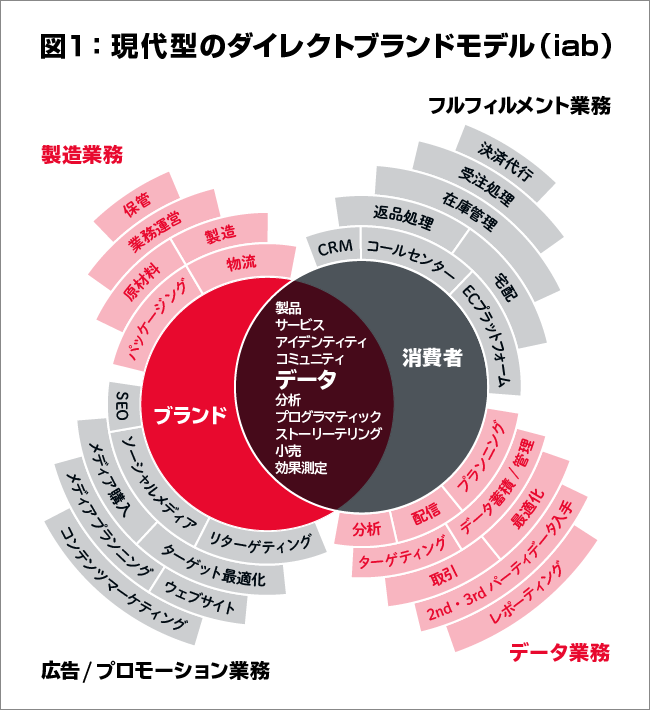How to Build a 21st Century Brand
In recent years, DTC (Direct To Consumer) brands—which build direct relationships with customers online to provide products and services—have surged across various categories.
For example, in the United States during the 2010s, a wave of digitally native ventures emerged, including Warby Parker (eyewear), Bonobos (apparel), Away (travel goods), and Glossier (cosmetics). These brands captured customer loyalty through innovative services and brand experiences, achieving rapid growth.
Regarding this rise of DTC brands, the U.S. Interactive Advertising Bureau (IAB) published a report titled " Disrupting Brand Preference Study " in July 2019. It presented findings based on large-scale consumer research and suggested a new brand-building model.
20th-century brands were mass-production manufacturer models built through indirect relationships with consumers via mass advertising and mass channels. In contrast, DTC brands (referred to as direct brands in the report) embody a completely different brand-building model. They connect directly with consumers through online/owned channels, where consumers function as co-creators in the brand-building process.
This new model, as shown in Figure 1, places direct experience provision and co-creation with consumers, along with data feedback, at the core of the entire business. Brands are built by efficiently and flexibly leveraging external resources for product development and manufacturing, fulfillment, advertising/promotion, data operations, etc., without rigidly insisting on in-house execution.
The IAB report introduces 250 direct brands that are pioneering new consumer preferences and sustaining growth. Notable categories include apparel, food, beauty, personal care, and lifestyle.
Surveys of US direct brand users revealed the following findings:
- Direct brand buyers account for 48% of U.S. residents aged 13 and older. These buyers tend to be younger, have higher incomes, and place greater emphasis on self-expression value than on product necessity.
- Direct brands are built through users' active experiences across various touchpoints. Furthermore, 71% of users actively share the brand, which itself becomes a brand value through self-expression.
- Users build loyalty not just through purchases, but through diverse engagement points based on subscriptions and proactive sharing/recommendation actions. They also desire 24/7 omnichannel access.
- Awareness pathways for direct brands are nearly evenly split between TV commercials, search, online shopping site ads, and social media ads.
- Influencer ratios among users are exceptionally high. Notably, "super influencers"—who possess their own distinct style while actively sharing brand information and content, thereby influencing others' brand choices—account for one-third of users.
Co-creating brand value by connecting directly with consumers
Notably, the rapidly growing direct brands possess unique brand stories and styles. They deliver value that changes user behavior and lifestyles through innovative ideas and digital-native technology.
Furthermore, the value brands can deliver by connecting with consumers—such as product personalization, self-selection, community building, continuity, and feedback—strongly aligns with users' desire for self-expression.
Many of these brands do not pursue mass-market scale through large retailers or online channels like Amazon. Instead, by establishing direct touchpoints with consumers and engaging with each individual, they deliver unique brand experiences and co-created value (where users become partners in brand building), achieving high profitability.
This direct brand business model, as shown in Figure 2, represents the embodiment of today's brand platform construction—one that achieves customer-centric value co-creation rather than being product-centric.
Furthermore, it is noteworthy that direct brands have recently accelerated the expansion of physical retail stores. While competing with traditional retail-centric brands, they are introducing a new perspective on retail strategy. Here, the purchasing experience seamlessly integrates online and offline channels. Physical stores become not just places to sell products but also "media" for brand experiences, contributing to online sales.
This rise of direct-to-consumer brands is also impacting the recent retail strategies of leading global brands like Apple, Nike, and UNIQLO, which became global players through the manufacturer-retailer model. Furthermore, moves like Unilever's $1 billion acquisition of Dollar Shave Club (a direct-to-consumer shaving brand) in 2016 are prompting major consumer goods brands to explore new 21st-century business models and pursue M&A of growth brands.
What opportunities does the direct-to-consumer model present in the Japanese market?
So, how should we interpret this direct-to-consumer brand trend in the Japanese market? Of course, differences exist compared to the US, such as channel environments (concentration, accessibility, convenience), the penetration of online shopping, and the influence and reach of users as influencers.
However, amid the rapid penetration of online purchasing and corporate digital transformation, the direct brand model still holds significant potential for manufacturers. This is because there is room for disruptive innovation, especially for many large corporations constrained by existing manufacturing facilities, distribution networks, and other supply chain ties that make it difficult to maneuver.
The long-term contraction of the domestic market due to population decline and shifts in consumer values mean the 20th-century model of mass production, mass advertising, and mass distribution is reaching its limits. The key to successful branding going forward will be whether we can create new value through technology and experiential innovation within relationships centered on each individual consumer.
Next time, we will explore the evolution of a new "retail branding" in this era of direct brands.






